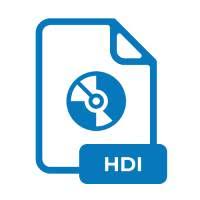.HDI File Extension

Hard Disk Image
| Developer | N/A |
| Popularity | |
| Category | Disk Image Files |
| Format | .HDI |
| Cross Platform | Update Soon |
What is an HDI file?
HDI files are essentially virtual replicas of entire hard disk drives or specific partitions. They encapsulate the data, file structure, and system configurations present on a disk, allowing users to store, replicate, or manipulate disk contents without the need for physical media.
These files serve various purposes, including system backup, software testing, and data recovery.
More Information.
The genesis of HDI files can be traced to the development of disk imaging software in the late 20th century.
Programs like Norton Ghost, PowerQuest DriveImage, and later, open-source tools like Clonezilla, played pivotal roles in popularizing disk imaging practices.
Initially, HDI files were primarily used for system backup and restoration, providing a reliable method for preserving data integrity and system configurations.
Origin Of This File.
The concept of disk imaging dates back to the early days of computing when the need arose to replicate entire disk contents for backup and recovery purposes.
As storage technology evolved, so did the methods of disk imaging. HDI files emerged as a convenient solution for creating, storing, and deploying disk images in a digital environment.
File Structure Technical Specification.
HDI files adhere to specific structural and technical standards to ensure compatibility and interoperability across different platforms.
Typically, they consist of a header section containing metadata and disk information, followed by a byte-for-byte replication of disk contents, including partition tables, file systems, and data clusters. The structure may vary slightly depending on the disk imaging software used to create the HDI file.
How to Convert the File?
Converting HDI files to other formats or vice versa may be necessary to ensure compatibility with specific software or operating systems. Several tools and methods can facilitate this process, including:
- Disk Imaging Software: Many disk imaging programs offer built-in features for converting between different image formats, including HDI.
- Third-Party Converters: Dedicated file conversion utilities are available online, allowing users to convert HDI files to popular formats like ISO or VHD.
- Virtualization Platforms: Virtual machine software like VMware or VirtualBox supports the direct import and conversion of HDI files into virtual disk formats compatible with various operating systems.
Advantages And Disadvantages.
Advantages:
- Data Preservation: HDI files enable the preservation of entire disk configurations, ensuring that no data is lost during backup or migration processes.
- Versatility: These files can be used for a variety of purposes, including system cloning, software testing, and forensic analysis.
- Efficiency: Disk imaging eliminates the need for manual file-by-file backups, streamlining the backup and recovery process.
- Portability: HDI files can be easily transferred across different storage devices and shared with other users, making them ideal for collaborative projects.
Disadvantages:
- File Size: Since HDI files contain byte-for-byte copies of disk contents, they can occupy significant storage space, especially for large drives or partitions.
- Compatibility: Not all disk imaging software may support the HDI format, limiting interoperability and portability.
- Complexity: Creating and managing HDI files may require technical expertise, particularly when dealing with disk partitioning and system configurations.
How to Open HDI?
Open In Windows
- Users can employ tools like PowerISO, Daemon Tools, or Virtual CloneDrive to mount HDI files as virtual drives and access their contents within Windows Explorer.
Open In Linux
- The Linux operating system offers native support for mounting disk images using utilities like “mount” or “loopback,” allowing users to access HDI files directly from the command line or file manager.
Open In MAC
- Applications such as Disk Utility or Parallels Desktop enable users to mount HDI files on macOS and access them as virtual disks.













